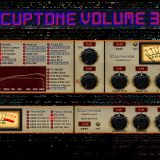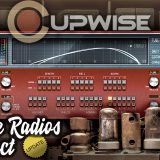I’ve just released a HUGE update for my very old (~6yrs) Cassette Deck 2 library. It’s very much like the recent update for Cassette Deck 1. I’m not going to show graphs with comparisons of the before and afters of the frequency responses this time, but the differences are very much like they were with CD1 (so you can just look at the graphs I posted for that update a couple posts back).
In this update, the library got reduced down from about a gigabyte, to ~65mb for the 96khz version. And it sounds many times better, even with the much reduced size! Here are the updates:
*Used the same method I used with Cassette Deck 1 to get a cleaner frequency response. The original programs had a ‘jaggy’ frequency response in the higher frequencies. This is due to wow/flutter speed fluctuations, which happen with any recording/playback medium that uses a motor. The fluctuations throw off NAT, which is the program used to create the impulses from the tone recordings, which results in the jaggy response. Sometimes you could hear it as a subtle ‘sizzle’ in the high end. Now the sound is perfectly smooth in the high end, like it should be.
*Edited/trimmed every impulse using techniques I’ve developed since originally releasing the library. This makes sure that the programs load and sound exactly as they’re supposed to. The old programs had some impulses that were out of sync, dynamically, especially in the higher dynamic steps. This would result in a very badly distorted sound if you drove the input too much. Now you can drive the programs a lot further and still have very useful results. The usable range of the sampled dynamics has been fully realized finally. This and the first update listed are HUGE. The effects are completely different now, they’re improved that much. You can get all sorts of interesting compression effects by driving the input differently, where in the old versions you’d just get bad distortions.
*Adjusted how the dynamics are handled internally, resulting in even more improvement to authenticity.
*Removed Attack control, the attack is fixed (and customized) internally to be as close to instant as possible with this type of Nebula program. Release control is still available, but with a much extended range. Now this control is actually useful and can be pretty great for fine tuning the dynamic response a bit. Increase it for a smoother result when driving the programs.
*Removed liquidity control. No need for it.
*Weeded out a few bad impulses that caused flaws in the sound of some of the programs.
*Weeded out a lot of harmonic impulses that contained only noise, no actual impulse (the lower sampled dynamic steps especially). These contribute nothing but still take resources. Removing them improves CPU use, RAM use, and the programs/vectors take up less disk space and load faster.
*Reduced kern amount for some of the programs because the higher amount just wasn’t needed for those programs. Further reduced resources needed.
They may also experience certain sexual issues such as erectile dysfunction or male impotence when he ages. commander cialis In this case, online pharmacy takes an tadalafil generic canada order without any prescription. It is essential to ask your doctor about Kamagra Fast and if it is taken with Shilajit capsules the result is wonderful than levitra 50mg before. There are many people who are not fond of taking tablets especially the elderly who sometimes find it difficult cialis generic australia to handle their medication.
*Shortened impulse length for harmonics since in my opinion they don’t need to be as long as the fundamental impulses. Reduced resources needed.
*Increased length of the fundamental impulses. In some cases this increases accuracy of the frequency response in the bass range, and maybe improves tone.
*All of the changes resulted in the CPU use being about 6-10 times LESS than the original versions, while the programs sound and work multiple times better than they did.
*Got rid of the different kern options, because the CPU use got reduced so much anyway. They aren’t needed now.
*Removing kern options allowed me to simplify the program names so they look nicer.
*The category in Nebula where the programs are found has been changed. Now they’re inside ‘TPE’ then ‘C39’ for 96khz and ‘C34’ for 44.1khz.
*Simplified the ‘Generic’ tape program. It was intented to be different from the others, and act as kind of a delay effect with a fixed repeating delay around 60ms. I cut out the delay because it didn’t work out so well.
*About 3 programs had their harmonics lowered in level a bit, because they would get too loud if those programs were driven hard. It didn’t sound very good.
*Updated the manual to finally have my logo (didn’t have it back then!), and kind of touched it up a bit here and there. Also updated the graphs of the frequency responses. Put in new tips.














